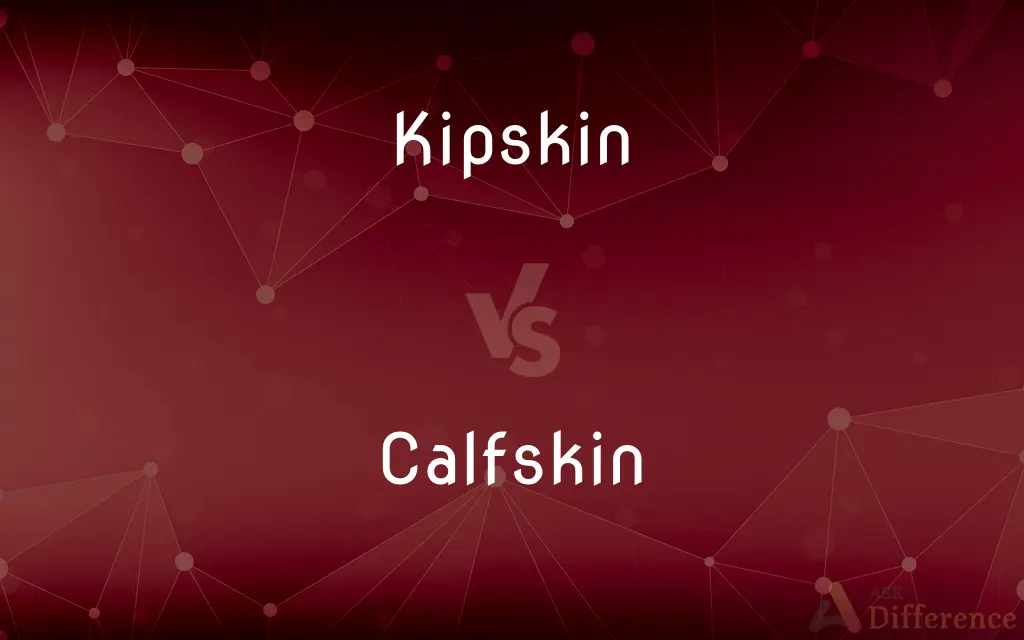Kipskin vs. Calfskin — What's the Difference?
By Maham Liaqat & Urooj Arif — Updated on April 7, 2024
Kipskin is tough and durable, used in heavy-duty leather goods; calfskin is softer, finer, and used in luxury items.

Difference Between Kipskin and Calfskin
Table of Contents
ADVERTISEMENT
Key Differences
Kipskin is a type of leather made from the hide of young or small cattle, known for its durability and used in items requiring toughness and resilience. It's thicker and less refined than some other leathers, making it ideal for heavy-duty applications such as boots, belts, and bookbindings. On the other hand, calfskin is highly prized for its softness, fine grain, and flexibility, making it a preferred material for high-end leather goods like luxury handbags, wallets, and shoes. Calfskin offers a smooth, refined finish that appeals to luxury markets, whereas kipskin is valued in contexts where strength and durability are paramount.
Kipskin, due to its robust nature, often undergoes less intensive treatments to preserve its natural strength and texture, which can result in a more natural, rugged appearance. This aspect makes it suitable for products where durability and the ability to withstand wear and tear are crucial. Calfskin, however, undergoes a series of treatments to enhance its softness and pliability, resulting in a more delicate and luxurious material that requires careful maintenance to retain its appearance and texture.
In terms of cost, kipskin is generally more affordable due to its wider availability and the fewer processes required to prepare it for use. This affordability makes it a popular choice for practical, everyday items. Calfskin, with its labor-intensive preparation process and association with luxury goods, often commands a higher price point, reflecting its status as a premium material in the fashion and luxury goods industries.
When it comes to environmental impact, the production of both kipskin and calfskin raises concerns related to sustainability and animal welfare. However, the impact varies depending on the sourcing and production practices of the leather. Efforts towards more sustainable practices, such as using hides from ethically raised cattle and employing environmentally friendly tanning methods, are increasingly important in both segments of the leather industry.
Both kipskin and calfskin have unique attributes that cater to different needs and preferences. While kipskin is sought after for its toughness and practicality in more rugged products, calfskin's appeal lies in its luxurious feel and aesthetic, making it a staple in the world of high-end fashion and luxury leather goods.
ADVERTISEMENT
Comparison Chart
Texture
Tough and durable, suitable for heavy-duty use.
Soft, fine, and flexible, ideal for luxury items.
Use
Boots, belts, bookbindings, and other durable goods.
Luxury handbags, wallets, shoes, and high-end accessories.
Treatment Process
Undergoes less processing, maintaining a natural look.
Heavily treated to enhance softness and flexibility.
Price
Generally more affordable due to fewer processing needs.
Higher priced, reflecting its premium quality and finish.
Environmental Impact
Depends on sourcing, but generally high due to leather production.
Also high, with a focus on luxury market sustainability efforts.
Compare with Definitions
Kipskin
Used in heavy-duty goods.
The book was bound in sturdy kipskin.
Calfskin
Pricier, reflecting its luxury status.
Calfskin accessories command a higher price.
Kipskin
Durable, thick leather.
He chose a kipskin belt for its durability.
Calfskin
Requires careful maintenance.
She treated her calfskin jacket with special conditioner.
Kipskin
Leather from young cattle, valued for toughness.
The kipskin boots lasted years without a scratch.
Calfskin
Soft, luxurious leather from young cows.
Her calfskin handbag felt incredibly smooth.
Kipskin
Affordably priced leather.
Kipskin offers great value for everyday items.
Calfskin
Fine-grained, high-quality material.
The calfskin wallet was worth every penny.
Kipskin
Less refined but strong.
Kipskin gloves are perfect for rough work.
Calfskin
Used in premium goods.
Designer shoes are often made of calfskin.
Kipskin
Leather prepared from the skin of young or small cattle, intermediate in grade between calfskin and cowhide.
Calfskin
Calfskin or calf leather is a leather or membrane produced from the hide of a calf, or juvenile domestic cattle. Calfskin is particularly valuable because of its softness and fine grain, as well as durability.
Kipskin
Leather prepared from the skin of young or small cattle, intermediate in grade between calfskin and cowhide.
Calfskin
Leather made from the hide or skin of a calf, used in bookbinding and shoemaking.
Calfskin
The hide of a calf.
Calfskin
Fine leather made from the hide of a calf.
Calfskin
A fine leather made from the hide of a calf.
Calfskin
The hide or skin of a calf; or leather made of the skin.
Calfskin
Fine leather from the skin of a calf
Common Curiosities
What is calfskin?
Calfskin is a soft, fine-grained leather from young cows, used in luxury leather goods.
What is kipskin?
Kipskin is a durable leather made from the hide of young or small cattle, used in items requiring toughness.
What items are typically made from calfskin?
Calfskin is preferred for luxury handbags, wallets, shoes, and high-end accessories.
Is kipskin more affordable than calfskin?
Yes, kipskin is generally more affordable due to its wider availability and fewer processing needs.
How should calfskin products be maintained?
Calfskin requires careful maintenance with conditioners and protectants to preserve its softness and appearance.
Is calfskin suitable for everyday use?
While durable, calfskin items, due to their fine texture and high cost, are often reserved for special occasions or require careful handling.
How does kipskin differ from calfskin in texture?
Kipskin is tougher and more durable, while calfskin is softer and finer.
How is kipskin treated compared to calfskin?
Kipskin undergoes less processing to maintain its natural strength, whereas calfskin is heavily treated for softness and flexibility.
What are common uses for kipskin?
Kipskin is used in boots, belts, bookbindings, and other items needing durability.
Which is more environmentally friendly: kipskin or calfskin?
Both have environmental impacts, but sustainability efforts focus on ethical sourcing and eco-friendly production practices.
Can kipskin be used in luxury goods as well?
While primarily used for its durability in practical items, kipskin can also be crafted into premium goods depending on the finish.
Are there any alternatives to kipskin and calfskin?
Synthetic leathers and leathers from other animals offer alternatives, each with its own set of characteristics and ethical considerations.
Why is calfskin considered a luxury material?
Calfskin's softness, fine grain, and flexibility make it ideal for high-end, luxurious leather goods.
Does the production of kipskin and calfskin affect animal welfare?
Yes, both involve ethical considerations regarding animal welfare, with industry efforts aiming to improve sourcing and treatment practices.
How do fashion and luxury brands justify the high cost of calfskin products?
The high cost is attributed to calfskin's premium quality, labor-intensive treatment processes, and association with luxury and exclusivity.
Share Your Discovery

Previous Comparison
Cardigan vs. Sweater
Next Comparison
Dishdasha vs. ThobeAuthor Spotlight
Written by
Maham LiaqatCo-written by
Urooj ArifUrooj is a skilled content writer at Ask Difference, known for her exceptional ability to simplify complex topics into engaging and informative content. With a passion for research and a flair for clear, concise writing, she consistently delivers articles that resonate with our diverse audience.
















































